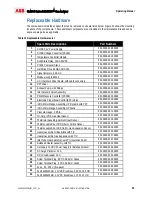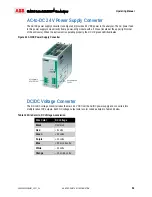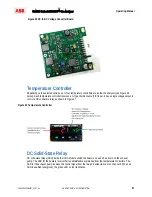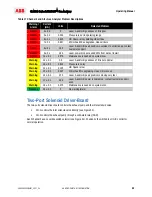
GLA531 Series LGR-ICOS™ Gas Analyzer
Operating Manual
3KXG165002R4201_2021_04
ABB PROPRIETARY INFORMATION
68
9 Basic Troubleshooting in ICOS Gas
Measurements
ABB
GLA531
Series
LGR-ICOS
TM
Gas Analyzers operate on a single-board computer (PC104 Stack) equipped
with
an Intel Atom microprocessor. This single-board computer is integrated with a digital signal processor
(DSP)
board multiple I/O (MIO) boards that control and collect all analog signals. These signals are processed,
and
output data are produced almost simultaneously. The stability of the output data depend upon: 1) gas
temperature, 2) gas pressure, 3) laser linelock, and 4) path length of the laser light. The
ICOS section describes these dependencies.
Gas Temperature
The analyzer performance is optimized for a specific temperature. Temperature controllers maintain the gas
temperature near this temperature. Additionally, heaters prevent condensation inside the ICOS cell.
Condensation contaminates the spectroscopy mirrors, which in turn significantly degrades the analyzer
performance. Condensation inside the ICOS cell can be avoided by heating the entire surface of the cell.
•
Temperature errors are reported on the Alarm Status display (see Figure 19).
•
If a channel 5 temperature warning or alarm occurs, verify the ambient operating temperature is within
the specified -20
o
C to +50
o
C, and the analyzer has had sufficient time (usually 30-60 minutes) to
reach equilibrium temperature. Operating outside of this specified temperature range may produce
errors in the measurements.
•
If the ambient temperature is within specification, contact ABB Service and report which heater is in the
warning/alarm state to receive further instructions.
Gas Pressure
The analyzer performance is optimized and calibrated at a specific pressure. Noise in the pressure directly
affects the precision of the gas concentration measurements. Operating outside the desired pressure also
contributes to inaccuracy of the measurements.
•
Noisy or out-of-range gas pressures are reported on the Alarm Status display (see Figure 19).
•
If the gas pressure warning or alarm occurs, first verify that the inlet pressure of the sample gas does
not exceed 7.25 psig (or 0.5 barg).
•
Constant gas pressure inside the ICOS cell is critical to the measurements. Over-pressure of the
incoming sample-gas creates instability of the ICOS pressure and may cause measurement errors.
•
If the inlet gas pressure is within specification, contact ABB Service for further instructions.
Laser Linelock and Self-Correction
Small drifts in laser wavelength are compensated automatically by tuning the laser temperature, thus providing a
dynamic response for locking the frequency of the laser. Refer to the two peaks of the absorption profile in Figure
56 below as an example. The analyzer may lose this laser frequency linelock, if it operates outside the boundary
of normal condition.
•
Linelock issues are reported on the Alarm Status display (see Figure 19).
•
An alarm or warning for Data Health (A) or (B) is usually an indication that the laser has lost linelock.




































